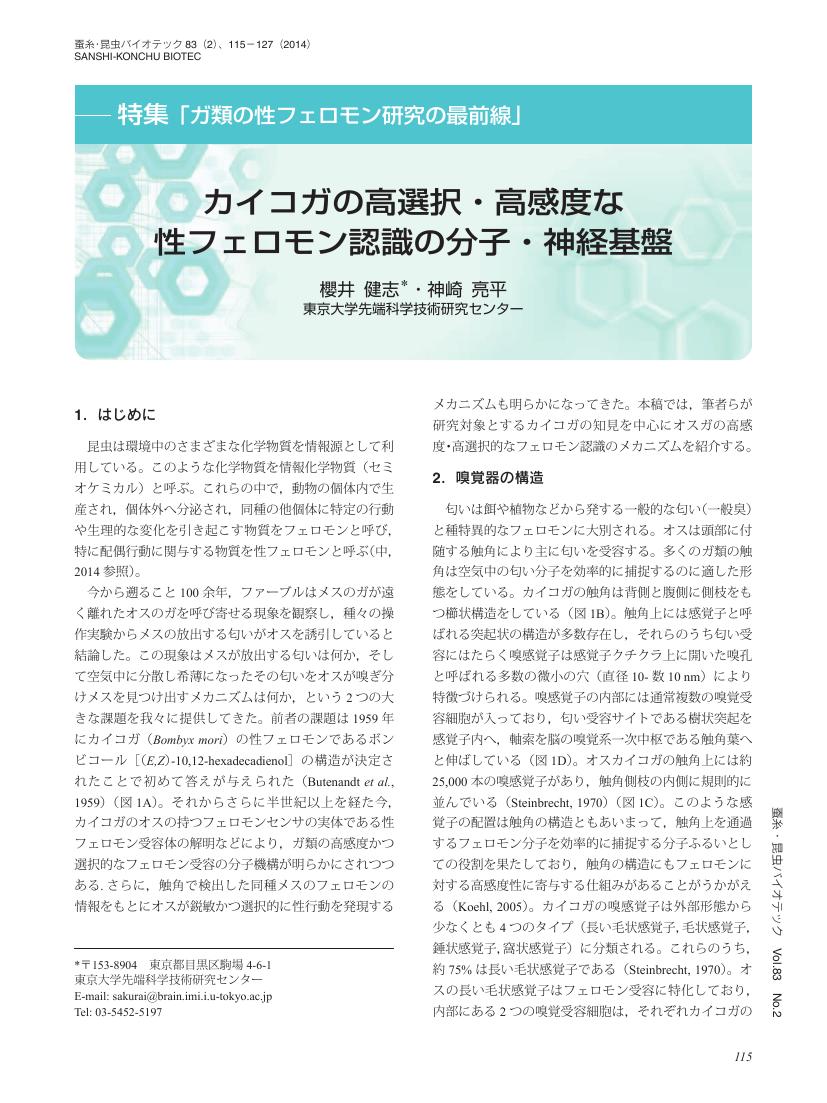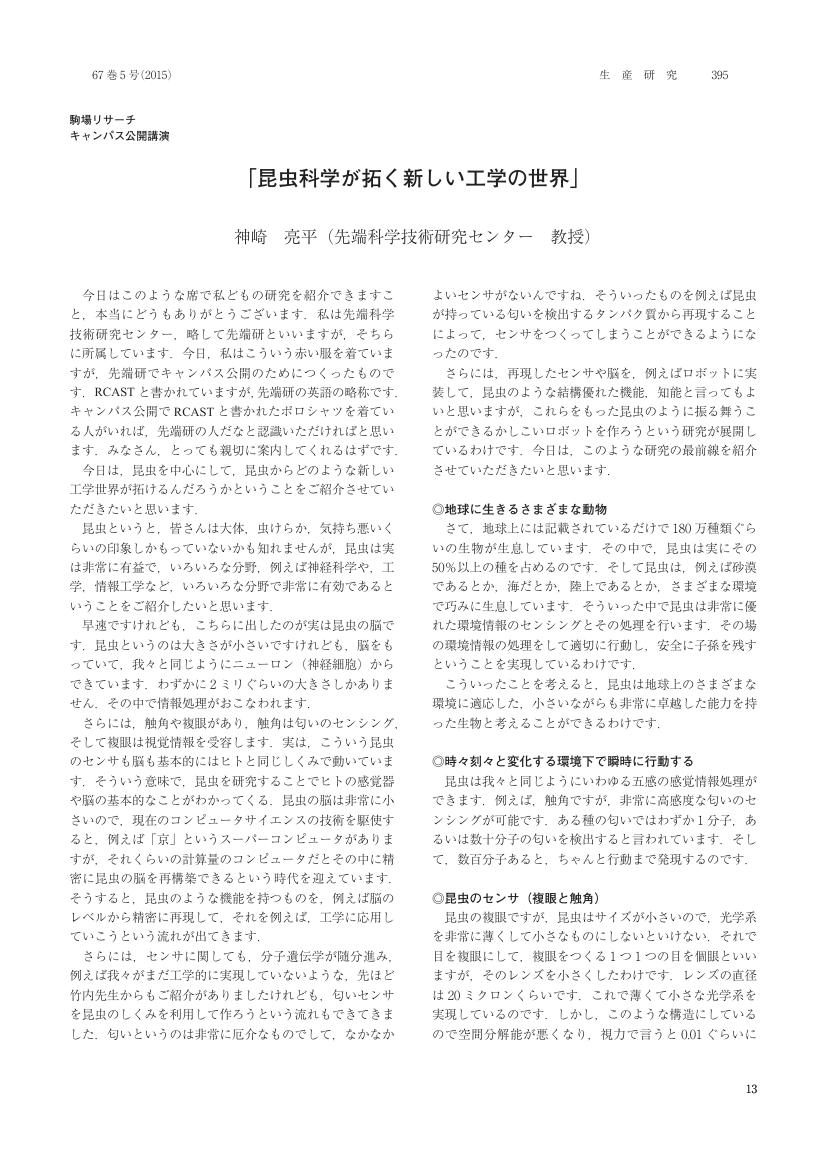6 0 0 0 OA カイコガの高選択・高感度な性フェロモン認識の分子・神経基盤
- 著者
- 櫻井 健志 神崎 亮平
- 出版者
- 社団法人 日本蚕糸学会
- 雑誌
- 蚕糸・昆虫バイオテック (ISSN:18810551)
- 巻号頁・発行日
- vol.83, no.2, pp.2_115-2_127, 2014 (Released:2014-11-03)
- 参考文献数
- 89
5 0 0 0 微小脳システムの適応的設計に関する研究成果取りまとめ
- 著者
- 高畑 雅一 冨永 佳也 神崎 亮平 青木 清 宗岡 洋二郎 水波 誠 山口 恒夫 堀田 凱樹 横張 文男 鈴木 良次 桑澤 清明 勝木 元也
- 出版者
- 北海道大学
- 雑誌
- 特定領域研究
- 巻号頁・発行日
- 1998
平成10〜13年度に実施した特定領域研究(A)「微小脳システムの適応的設計」の研究成果を、2つの研究項目についてそれぞれの班長および領域代表が中心となって詳細に吟味し、領域としての到達点と今後の展望を取りまとめて、研究成果報告書を作成し関係者に配付した。到達点として特に着目される業績としては、感覚連合中枢であるキノコ体のモジュール構造の発見やキノコ体のシグナル伝達機構の解明、また、湿度温度受容を含む機械感覚統合に関する多くの新しい知見などがあげられる。研究報告書には、計画および公募研究課題で公表された主要論文の別刷を添付し、最終的は400頁を越える分量となった。また、平成14年10月に文部科学省にて実施された最終ヒアリングにおいて、領域代表と研究項目代表者が出席して、領域研究の成果が、<わが国における節足動物微小脳による行動制御機構の研究を、従来の個々のモダリティーの感覚情報処理、個々の種特異的行動のパターン形成機構、具体的行動から単離され一般化された神経回路網の学習・記憶機構などの研究から、個体レベルの行動の多様性および複雑性と密接に関連づける研究という方向に向けて、大きく舵を切ったものと意義づけられる>という結論を報告し、審査員と質疑応答を行った結果、<期待どおり研究が進展した>との評価Aを受けた。また、審査報告に述べられた<今後もさらに個体レベルの行動の多様性や複雑性の解明へと取り組んでいただきたい>とのコメントを受け、次年度からの新しい微小脳プロジェクト申請のための打合せ会議を開催し、「微小脳システムの適応的設計」での成果をさらに発展させる目的で平成15年度特定領域研究「コミュニケーションのニューロン機構」(領域代表横張文男福岡大学教授)を申請した。
5 0 0 0 OA 昆虫の神経系と適応行動
- 著者
- 神崎 亮平
- 出版者
- The Robotics Society of Japan
- 雑誌
- 日本ロボット学会誌 (ISSN:02891824)
- 巻号頁・発行日
- vol.23, no.1, pp.27-31, 2005-01-15 (Released:2010-08-25)
- 参考文献数
- 13
- 被引用文献数
- 3 3
3 0 0 0 OA 昆虫全脳シミュレーションへむけて —その構成技術と進展—
- 著者
- 加沢 知毅 宮本 大輔 後藤 晃彦 朴 希原 福田 哲也 神崎 亮平
- 出版者
- 日本神経回路学会
- 雑誌
- 日本神経回路学会誌 (ISSN:1340766X)
- 巻号頁・発行日
- vol.22, no.3, pp.89-102, 2015-09-05 (Released:2015-10-30)
- 参考文献数
- 49
- 被引用文献数
- 2
現在の超並列スパコンの発展は,昆虫脳程度の神経回路ならほぼリアルタイムの詳細シミュレーションが可能な計算力を提供しつつある.ここでは,並列化によって提供される膨大な計算力を昆虫脳シミュレーションに適用するために我々が開発してきた技術的進展とその応用,すなわち NEURON シミュレータの並列・最適化を中心に,それを使用した単一ニューロンのパラメータ推定,ボトムアップで再構成する触角葉神経回路シミュレーションやトップダウンで設計する画像認識の機能をもたせる神経回路構築などを紹介する.
1 0 0 0 OA 昆虫の環境適応行動の発現機構
- 著者
- 神崎 亮平
- 出版者
- 公益社団法人 計測自動制御学会
- 雑誌
- 計測と制御 (ISSN:04534662)
- 巻号頁・発行日
- vol.44, no.9, pp.615-620, 2005-09-10 (Released:2009-11-26)
- 参考文献数
- 15
- 被引用文献数
- 1
1 0 0 0 OA 「昆虫科学が拓く新しい工学の世界」
- 著者
- 神崎 亮平
- 出版者
- 東京大学生産技術研究所
- 雑誌
- 生産研究 (ISSN:0037105X)
- 巻号頁・発行日
- vol.67, no.5, pp.395-403, 2015-09-01 (Released:2015-10-05)
- 著者
- 勝又 聡一郎 安藤 規泰 神崎 亮平
- 出版者
- The Robotics Society of Japan
- 雑誌
- 日本ロボット学会誌 (ISSN:02891824)
- 巻号頁・発行日
- vol.27, no.7, pp.711-717, 2009-09-15
- 被引用文献数
- 1
We developed an two-wheeled insect-sized robot to evaluate odor source localization algorithms of the male silkmoth (<i>Bombyx mori</i>). For fast and stable acquisition of sensory information, we used atmospheric ions and ion sensors to simulate odorant catch by insect olfactory sensors. The robot has two ion sensors, and a microcomputer for processing the sensor output, motor control and communication with external devices. To minimize its size, we used two modified servomotors as actuators, which enabled the robot to move in the same manner as a walking silkmoth. We used wheel encoders for feedback control of wheel position. The encoder output can also be used as a simulation of optic flow, which is necessary for speed and turn control in insect locomotion. By employing the robot, we evaluated the performance of two odor source localization models: one is based on the fixed programmed behavior of the silkmoth and a second model additionally includes course control dependent on the amplitude difference of ion sensor output on opposite sides of the robot. The results indicate that the robot based on the latter model was superior in ion plume tracking. Further evaluations of algorithms using our insect-sized robot will be an important tool for understanding behavioral mechanisms of orientation and applying them to robotics.
1 0 0 0 OA 膜電位感受性色素による匂い情報処理過程の解析-最大エントロピー法の利用
- 著者
- 岡田 公太郎 神崎 亮平
- 出版者
- 一般社団法人 日本生物物理学会
- 雑誌
- 生物物理 (ISSN:05824052)
- 巻号頁・発行日
- vol.43, no.2, pp.101-104, 2003 (Released:2003-03-25)




